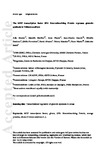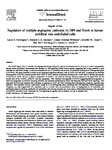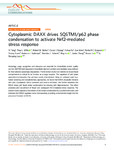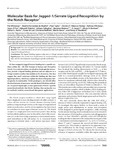The bZIP transcription factor SPA Heterodimerizing Protein represses glutenin synthesis in Triticum aestivum
| dc.contributor.author | Plessis, Anne | |
| dc.contributor.author | Boudet, J | |
| dc.contributor.author | Gaudin, J-C | |
| dc.contributor.author | Merlino, M | |
| dc.contributor.author | Dardevet, M | |
| dc.contributor.author | Perrochon, S | |
| dc.contributor.author | Alvarez, D | |
| dc.contributor.author | Risacher, T | |
| dc.contributor.author | Martre, P | |
| dc.contributor.author | Ravel, C | |
| dc.date.accessioned | 2018-12-06T16:34:09Z | |
| dc.date.issued | 2018-11-16 | |
| dc.identifier.issn | 0960-7412 | |
| dc.identifier.issn | 1365-313X | |
| dc.identifier.uri | http://hdl.handle.net/10026.1/12997 | |
| dc.description.abstract |
<jats:title>Summary</jats:title><jats:p>The quality of wheat grain is mainly determined by the quantity and composition of its grain storage proteins (<jats:styled-content style="fixed-case">GSP</jats:styled-content>s). Grain storage proteins consist of low‐ and high‐molecular‐weight glutenins (<jats:styled-content style="fixed-case">LMW</jats:styled-content>‐<jats:styled-content style="fixed-case">GS</jats:styled-content> and <jats:styled-content style="fixed-case">HMW</jats:styled-content>‐<jats:styled-content style="fixed-case">GS</jats:styled-content>, respectively) and gliadins. The synthesis of these proteins is essentially regulated at the transcriptional level and by the availability of nitrogen and sulfur. The regulation network has been extensively studied in barley where <jats:styled-content style="fixed-case">BLZ</jats:styled-content>1 and <jats:styled-content style="fixed-case">BLZ</jats:styled-content>2, members of the basic leucine zipper (<jats:styled-content style="fixed-case">bZIP</jats:styled-content>) family, activate the synthesis of hordeins. To date, in wheat, only the ortholog of <jats:styled-content style="fixed-case">BLZ</jats:styled-content>2, Storage Protein Activator (<jats:styled-content style="fixed-case">SPA</jats:styled-content>), has been identified as playing a major role in the regulation of <jats:styled-content style="fixed-case">GSP</jats:styled-content> synthesis. Here, the ortholog of <jats:styled-content style="fixed-case">BLZ</jats:styled-content>1, named SPA Heterodimerizing Protein (<jats:styled-content style="fixed-case">SHP</jats:styled-content>), was identified and its involvement in the transcriptional regulation of the genes coding for <jats:styled-content style="fixed-case">GSP</jats:styled-content>s was analyzed. In gel mobility shift assays, <jats:styled-content style="fixed-case">SHP</jats:styled-content> binds <jats:italic>cis</jats:italic>‐motifs known to bind to <jats:styled-content style="fixed-case">bZIP</jats:styled-content> family transcription factors in <jats:styled-content style="fixed-case">HMW</jats:styled-content>‐<jats:styled-content style="fixed-case">GS</jats:styled-content> and <jats:styled-content style="fixed-case">LMW</jats:styled-content>‐<jats:styled-content style="fixed-case">GS</jats:styled-content> promoters. Moreover, we showed by transient expression assays in wheat endosperm that <jats:styled-content style="fixed-case">SHP</jats:styled-content> acts as a repressor of the activity of these gene promoters. This result was confirmed in transgenic lines overexpressing <jats:italic><jats:styled-content style="fixed-case">SHP</jats:styled-content></jats:italic>, which were grown with low and high nitrogen supply. The phenotype of <jats:italic><jats:styled-content style="fixed-case">SHP</jats:styled-content></jats:italic>‐overexpressing lines showed a lower quantity of both <jats:styled-content style="fixed-case">LMW</jats:styled-content>‐<jats:styled-content style="fixed-case">GS</jats:styled-content> and <jats:styled-content style="fixed-case">HMW</jats:styled-content>‐<jats:styled-content style="fixed-case">GS</jats:styled-content>, while the quantity of gliadin was unchanged, whatever the nitrogen availability. Thus, the gliadin/glutenin ratio was increased, which suggests that gliadin and glutenin genes may be differently regulated.</jats:p> | |
| dc.format.extent | 858-871 | |
| dc.format.medium | Print-Electronic | |
| dc.language | en | |
| dc.language.iso | en | |
| dc.publisher | Wiley | |
| dc.subject | SPA Heterodimerizing Protein | |
| dc.subject | bZIP transcription factor | |
| dc.subject | gluten | |
| dc.subject | storage proteins | |
| dc.subject | wheat (Triticum aestivum L.) | |
| dc.subject | Basic-Leucine Zipper Transcription Factors | |
| dc.subject | Gene Expression Regulation, Plant | |
| dc.subject | Glutens | |
| dc.subject | Plant Proteins | |
| dc.subject | Plants, Genetically Modified | |
| dc.subject | Protein Multimerization | |
| dc.subject | Triticum | |
| dc.title | The bZIP transcription factor SPA Heterodimerizing Protein represses glutenin synthesis in Triticum aestivum | |
| dc.type | journal-article | |
| dc.type | Journal Article | |
| dc.type | Research Support, Non-U.S. Gov't | |
| plymouth.author-url | https://www.ncbi.nlm.nih.gov/pubmed/30444293 | |
| plymouth.issue | 5 | |
| plymouth.volume | 97 | |
| plymouth.publication-status | Published | |
| plymouth.journal | Plant Journal | |
| dc.identifier.doi | 10.1111/tpj.14163 | |
| plymouth.organisational-group | /Plymouth | |
| plymouth.organisational-group | /Plymouth/Faculty of Science and Engineering | |
| plymouth.organisational-group | /Plymouth/Faculty of Science and Engineering/School of Biological and Marine Sciences | |
| plymouth.organisational-group | /Plymouth/REF 2021 Researchers by UoA | |
| plymouth.organisational-group | /Plymouth/REF 2021 Researchers by UoA/UoA06 Agriculture, Veterinary and Food Science | |
| plymouth.organisational-group | /Plymouth/Users by role | |
| plymouth.organisational-group | /Plymouth/Users by role/Academics | |
| dc.publisher.place | England | |
| dcterms.dateAccepted | 2018-10-31 | |
| dc.rights.embargodate | 2019-11-16 | |
| dc.identifier.eissn | 1365-313X | |
| dc.rights.embargoperiod | Not known | |
| rioxxterms.versionofrecord | 10.1111/tpj.14163 | |
| rioxxterms.licenseref.uri | http://www.rioxx.net/licenses/all-rights-reserved | |
| rioxxterms.licenseref.startdate | 2018-11-16 | |
| rioxxterms.type | Journal Article/Review |





